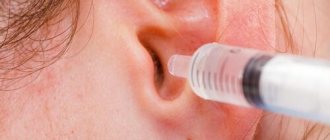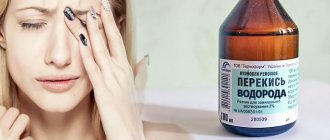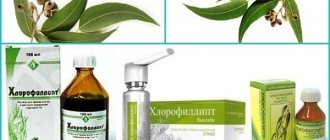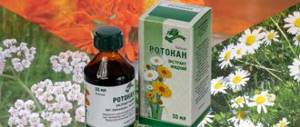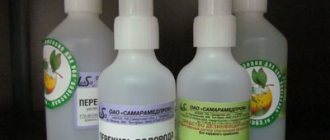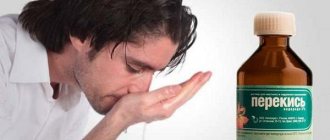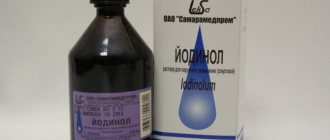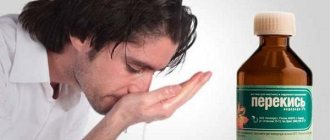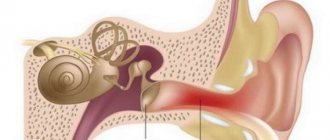Is it possible to gargle with hydrogen peroxide?
Peroxide for gargling is used for all types of inflammatory and purulent processes. The product is non-toxic, safe for children and pregnant women and effectively treats pathological conditions of the nasopharynx. For what diseases can it be used:
1
Catarrhal sore throat is a viral disease that begins with an increase in temperature to 37.2-39 ° C and a sharp sore throat. In the pathology, the tonsils and mucous membranes are affected, but the inflammation is superficial, and the disease is mild. For sore throat, it is recommended to rinse the larynx and treat the tonsils.
2
Follicular tonsillitis - with this pathology, the tonsils are covered with small inflamed follicles filled with purulent contents. The patient complains of soreness, pain, swelling of the larynx, and the temperature rises to 40°C.
For sore throats and suppuration of the follicles, such treatment is especially effective; it allows you to cleanse the mucous membrane, destroy bacteria and push pus out. In addition to rinsing and treating the larynx, antibacterial therapy is needed.
3
ARVI - in the absence of treatment, a banal viral infection is complicated by a sore throat, so peroxide in this case is used not only for therapy, but also for prevention. ARVI is accompanied by swelling of the throat mucosa, redness and mucus secretion, which the drug effectively washes away, restoring and protecting the epithelium.
4
Pharyngitis is a diffuse inflammation affecting the back wall of the larynx, palatine arches and uvula. You need to start rinsing when the first symptoms are detected in order to prevent the development of a bacterial infection.
Before starting treatment, especially for children, you should visit a doctor and get additional recommendations. Perhaps, in addition to rinsing and external treatment, antibiotics, antiviral agents, inhalations and other auxiliary manipulations are needed.
Indications for use
Hydrogen peroxide has been used to treat throat problems for a long time. Long-term use has proven that it can be successfully used for the following pathologies:
- Sore throats of various types. The remedy is especially effective for purulent and follicular tonsillitis.
- Chronic tonsillitis. The disease develops after a sore throat, and the use of peroxide helps prevent exacerbation of the pathology.
- Laryngitis. With this disease, the inflammatory process is located in the larynx, and a solution of hydrogen peroxide is used to gargle.
- Pharyngitis. Inflammation spreads to the pharynx. Rinse your throat with peroxide.
- Cold. This is a disease caused by hypothermia of the throat with cold water or air when breathing through the mouth. Peroxide relieves symptoms of inflammation.
- Nasopharyngitis. Inflammation occurs from bacterial and viral effects. A lot of mucus and pus are released. The product clears the airways well and improves the patient's condition.
Doctors recommend using a solution of hydrogen peroxide, but it is not a remedy. More often it is used for prophylaxis to avoid complications from diseases. You need to treat your throat with medications prescribed by your doctor.
Hydroperite tablets
Medicinal properties
For inflammation of the tonsils and mucous tissue, adults and children can gargle with peroxide; the product is an excellent antiseptic and quite safe.
It is a clear, odorless liquid with a slight metallic taste; it dissolves easily in water. If the drug is released in tablet form, it is called hydroperite.
It has oxidative and reductive properties, is very effective even for purulent inflammation of the ENT organs, destroys viruses, fungi and bacteria, eliminates redness and soothes tissues. The medicinal properties are as follows:
1
Disinfection - thanks to this, viruses, bacteria and yeast-like fungi die, which is why it is used in the treatment of the nose, throat, purulent lesions on the skin, cuts and ulcers.
2
Oxygen enrichment - treated tissues are more easily saturated with nutrients and oxygen, which affects rapid recovery and healing. Pain also goes away and the healing process accelerates.
3
Increased blood circulation - after treatment, blood flows better to the affected area, tissues are restored faster.
4
Increasing local immunity - treatment with the product stimulates the body’s own protective functions, increasing the ability of the laryngeal epithelium to independently fight infectious agents.
5
Cleansing - when the throat becomes inflamed, the enzyme catalase is formed on the surface of the mucous membrane. The drug comes into contact with it, forming foam, with which particles of pus and dirt, as well as dead tissue, come out of the layers of tissue. Thanks to this action, the mucous membrane heals faster and is cleansed much deeper.
Source: nasmorkam.net If the drug is used correctly in the treatment of inflammation of the larynx, after 1-2 days you can notice an improvement in well-being, cleansing of the mucous membrane from purulent-necrotic plaque, and a decrease in temperature.
Particular attention is paid to the product by people who do not want to immediately begin drug treatment for colds and inflammatory diseases, because peroxide is a safe and effective antiseptic.
Pharmacological properties and use for throat pathologies
Hydrogen peroxide, or peroxide as it is also called, is used for various throat diseases caused by pathogenic microflora. The product has the property of releasing active oxygen on the mucous membranes, so its use is accompanied by hissing and rapid formation of foam. Thanks to this property, peroxide is good at cleaning surfaces affected by inflammation.
This is a very valuable property for the throat. After all, inflammation in it is often accompanied by the formation of pus and waste products of bacteria. Hydrogen peroxide works well and clears the throat. And this promotes the healing of wounds and inflammatory processes occurring there.
Peroxide also has a bactericidal effect. It not only cleanses wounds, but also kills bacteria that have settled in them.
Thanks to these properties, when using peroxide, blood circulation is normalized and metabolic processes are activated. This makes healing happen faster.
Ready-made 3% hydrogen peroxide solution
Contraindications
It is worth saying that this is a unique remedy that, when used correctly locally, cannot harm the body.
Even pregnant women and people suffering from various pathologies can be treated with it, but the drug has one contraindication - an allergy to its composition.
In all other situations, in the absence of a predisposition to a negative reaction, it can be used without fear.
Do not allow the rinse solution to be swallowed or interfere with its concentration. For many diseases, peroxide is also used internally, but during treatment it is extremely undesirable to swallow the composition.
Possible side effects
Treatment of the throat with hydrogen peroxide is an effective and safe procedure. Unexpected reactions of the body rarely occur to it; the only exception is an allergy to the composition.
Side effects may occur if the dosage is violated during the preparation of the mixture (if you add too much). The condition is manifested by the following symptoms:
- the appearance of cough and nasal discharge;
- lethargy and drowsiness;
- nausea;
- labored breathing.
If suddenly after rinsing it becomes difficult to breathe and your health suddenly worsens, it is better to seek help from a doctor.
In addition to an overdose of the product in solution, you can get a burn to the mucous membrane or swallow a low-quality composition. Injury to the epithelium of the throat will signal itself through dryness, soreness and a feeling of discomfort.
Precautionary measures
Treating a throat with hydrogen peroxide is simple at first glance, but in order for the therapy to be safe, you need to follow a number of simple rules. So you can use 3 percent liquid; higher concentrations will not work. The precautions are:
- For treatment, only pharmacy peroxide is used, you need to ensure a good shelf life;
- You can only rinse with a diluted product, you cannot use it in its pure form;
- sometimes they use a mixture of water, peroxide and baking soda, but you should not prescribe this treatment yourself - you need to consult a doctor. More often, this solution is used to treat inflamed gums;
- You cannot change the dosage of peroxide, which is diluted in water. If less is added - nothing, but the effect will come more slowly. Adding more may cause burns;
- The composition is diluted with soft purified water and used immediately; there is no need to store the finished mixture or make it for future use.
It should be borne in mind that rinsing does not exclude the continuation of therapy with sprays, lozenges and inhalations prescribed by a doctor.
Between procedures you should take a break of at least 30 minutes. You should not exceed the amount of peroxide in the solution in the hope that this will improve the effect of treatment and recovery will come faster. So, in addition to inflammation of the larynx, trauma to the mucous membrane will also occur.
Side effects
It is usually safe when used correctly. But sometimes it can cause side effects - primarily local in the form of irritation of the mucous membranes of the throat. This occurs in people with individual intolerance to the drug. This becomes noticeable after 1-2 procedures. If this occurs, you should stop using peroxide.
In rare cases, general symptoms such as drowsiness, general fatigue and nausea may occur. Sometimes you may experience a severe cough or runny nose. This also becomes the reason why you should not use this remedy.
How to dilute hydrogen peroxide for gargling?
It is necessary to clarify that it is necessary to use a warm composition - a hot one can cause a burn to the mucous membrane, and a cold one will not provide a therapeutic effect. For a quick onset of effect, you need to properly dilute the drug, observing certain proportions. There are two options for preparing the composition:
- mix 100 ml of purified soft (warm) water and a tablespoon of the product at a concentration of 3%;
- or dissolve one tablet of hydroperite in a glass of warm boiled water.
Which option to choose is up to each patient to decide; if you have tablets at home or a recently purchased peroxide solution, you can use either one. The only condition is to monitor the expiration date of the drug so as not to harm the body with low-quality liquid.
Preparation
Having chosen the appropriate dilution method, we must not forget about preparing the composition for rinsing the larynx. After the procedure, it is imperative to rinse the throat to wash off the product remaining on the surface of the epithelium, otherwise the patient risks burning the mucous membrane. The following compositions are suitable for this purpose:
- heated boiled water;
- a decoction of medicinal herbs with soothing and healing properties - chamomile, calendula, coltsfoot, plantain;
- low concentration saline solution or with the addition of a small amount of soda;
- a slightly diluted solution of potassium permanganate.
Each time before gargling, you need to prepare another glass for gargling - you can alternate herbs with salt, then potassium permanganate with boiled water.
This enhances the antiseptic and healing effect, and the restoration of the mucous membrane will occur faster. Also, before starting, you need to prepare your throat - to do this, rinse it with boiled water, then with calendula tincture, and only then can you take on the solution with peroxide.
How to gargle with peroxide?
The procedure itself is carried out as follows: two glasses are prepared (the medicinal composition itself and the mixture for rinsing after), then the patient takes a solution of 3% peroxide with water into his mouth and throws his head back a little.
While rinsing, you should pronounce any vowel sound in a drawn-out manner - this way the liquid will better wash the tonsils, clearing them of purulent plaque. At the same time, such treatment helps relieve inflammation from the posterior laryngeal wall and the root of the tongue.
It is important to observe the duration of rinsing so that the composition has time to penetrate the layers of the epithelium and push out the waste products of microorganisms. To do this, take a fresh solution, gargle for 30 seconds, spit, and so on until all 120 ml of peroxide are gone.
Afterwards, be sure to gargle with the prepared mixture in a second glass. For 120 ml of water with peroxide you will need 200 ml of a neutralizing composition; they also rinse the larynx for 30 seconds until the product runs out.
You can rinse the larynx 4-5 times a day, but not more often, observing the concentration of the liquid and safety precautions. If after 5-6 sessions the necrotic plaque is completely washed away from the surface of the mucous membrane, the peroxide can be left and rinsed only with herbal decoctions or salt and soda.
To kid
How to rinse a child’s larynx so that it is safe and brings the desired effect? You need to make sure that your baby knows how to rinse, otherwise he will swallow the solution or begin to choke on it.
Children under three years of age are not allowed to use such rinses. For a child, a decoction of chamomile is more suitable as a neutralizing composition, rather than potassium permanganate or salt with soda. The procedure is carried out for 20 seconds, otherwise the technique does not differ from that of an adult. [ads-pc-1][ads-mob-1]
During pregnancy
The rinsing technique for pregnant women does not differ from the usual one used by adults. If the expectant mother is afraid of side effects, you can make a solution of lower concentration - add not one, but half the prescribed dose to half a glass of water.
The drug does not penetrate the blood-brain barrier, so local use does not have a negative effect on the developing fetus.
